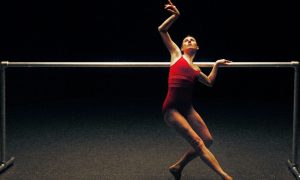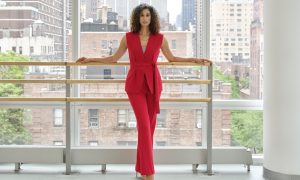RISD Auditorium, Providence, RI.
July 21, 2024.
If you’re from Rhode Island, you’ve heard all the small state jokes (and, in all fairness, it takes a mere hour to drive across the state). Yet, Revolve Dance Project’s Season 3 performance had me wondering if our little home could soon get on the map as a haven for great dance and live arts. The program was just as pleasing, as technically commanding, as resonant as anything I can remember seeing in New York City (dance’s capital in the U.S., and arguably in the world).
Either way, what was also clear was that this Providence, RI-based company – fostering connection between original dance and music, both performed live – is moving on up and making a name for itself. The show was in a notably larger venue than their former two seasons, and with works from Lauren Lovette and Justin Peck on the bill. Even so, these artists didn’t seem to take themselves too seriously. Everything still felt accessible, welcoming and admirably humble considering the beauty on offer.
Shifts and developments from Kirsten Evans, the artist at the helm, mirror that balance of accomplishment and humility. She has moved on and up herself, making the big move to New York City in 2023. Yet, as a former dancer with Ballet RI, she hasn’t lost touch with this little state and the company she founded there. Rather, she’s bringing connections and capacities from the Big Apple here – to locals’ benefit.
As part of that humility, a “short and sweet” quality was definitely at hand – in each work and in the program as a whole (at just over an hour total, no intermission). I’m all for that; personally, I think audience members feel plenty satisfied seeing something well-developed, but not overstaying its welcome…in, out, and on with life.
In the same vein, there was plenty of athleticism on offer – but never for its own sake. Gaze, moments of stillness, compelling concept, thoughtful structure, kinetic integration: those essential ingredients, present in each work, were what stuck with me long after I left the theater.
For Trevor, a dazzling solo from Laine Habony and danced by Indiana Woodward, epitomized this pleasing balance of the pedestrian and technical. Woodward’s gorgeous lines built each thoughtful shape, even as the vocabulary moved at breakneck speed. That was not speed for speed’s sake, but for musicality – for aesthetic confluence with the live score from Trevor Rabin.
Never missing a beat, Woodward’s musicality had me feeling just as attuned to the score’s textures and layers. I later found out that Woodward had an even deeper connection to the music; Rabin is her uncle, and she’s always wanted to dance to his music (so touching!). To end the solo, she dropped to the stage in seeming exhaustion – 100 percent physically spent. Laughing to myself, I also couldn’t blame her!
Most of the program’s other works were duets: each unique, but with the common thread of intimate connection. That was not in a fairy tale, “happily ever after” feeling, but rather truthful kinetic illustration of intimacy’s joys and struggles. I tend to have an aversion to “sappy,” sticky-sweet romance, but the authenticity and complexity here had me feeling engaged and invested. Solo sections in the midst of duets also allowed for the fullness of each dancer – of their artistry and personhood – to shine forth, as individuals and not only as one of a pair.
The program kicked off with Lovette’s duet Bones (danced by Evans and Luis Ocaranza, drums by Cameron MacIntosh). Enticingly rhythmic, tenacious in movement vocabulary, it was perfect for capturing audience members right off the jump. As much as Lovette took risks and called the duet partners to flex their technical muscles (literally and figuratively), they also offered ease and receptivity. As much as they reached through fingers and stretched limbs impossibly long, their spines rippled and snaked. They walked off confidently to end the work: enough said, enough danced.
Something softer followed, Laine Habony’s heartwarming duet Tracing the Figures of Love (danced by Kailee Felix and Kobe Atwood Courtney). Daniel Hass’s score was light, the dancers’ empire dresses (by Emily Lovdahl) breezy: the kind of easy elegance that’s a soul balm. Through lifts, leans and lunges, the partners supported each other – creating a sense of deep, genuine connection between them.
On a deeper and more systemic level, works like these expand the boundaries of gender in ballet – while very much remaining truthful to ballet’s essence. As William Forsythe has noted, we can receive the ballet tradition’s gifts while also not letting it box us in.
Dara Nicole Capley’s Harborage, danced by Katie Bickford and Joe Lynch, felt just as bold and earnest. The pair began by pushing a couch to center stage – to which they returned intermittently. There they cuddled, sought understanding, and leaned for support. Unease hummed through both the score and movement, yet to harmony the partners ultimately returned. Long, lifted lines juxtaposed grounded contractions, continuity counteracted accent.
Capley has a unique approach to making the highly technical something more released, more human, more conducive to honest storytelling. For their part, Bickford and Lynch realized that capacity through attuned, intelligent theatricality. Putting the cherry on top of that evocative story told on their bodies, they ended the work by pushing the couch back towards offstage: facing the challenges of sustained intimacy together. They were a team, whatever the future would bring.
Clara Miller’s duet Just a Beginner, danced by Brenna Zgodic and Jake Preece, had some of that heaviness in intimacy – yet also some of the light sweetness of Tracing the Figures of Love. The evident honesty and relatability filling the stage began with the dancers’ street clothes and sneakers – and got more evident from there. Just as much as they turned, leapt, and executed complex lifts, they breathed through moments to just be – such as when Zgodic handed off her light jacket to the musician (also Miller, on guitar and vocals).
Zgodic brought striking softness to the most precise of technical precision. Lynch moved with the kind of pliable strength that makes me love watching accomplished male dancers in their element (and occasionally musing on how we get more boys into dance classes!). Together, they were just as wonderful to watch. Except for those lovely moments of stillness, the momentum kept circling: through and between their bodies, the resonance echoing right out to us in the audience.
Emily Adams’ beautifully imagistic Pulse closed the program. With most of the afternoon’s performers dancing, their unique capacities coming together within an ensemble work was a stellar bow tying it all off. Dancers turning from a more slowly moving axis, they reminisced orbits. Reaching and rippling through spines and limbs, they reflected ocean waves – or waves of grain swaying in gentle breeze. Strong port de bras offered more concrete shapes, those to watch form and then shift into new forms.
As in Just a Beginner, momentum kept flowing. Physical science tells us that energy never dies, it’s only converted. I saw that here on moving bodies, as clear as daylight. Speaking of daylight, it hit my eyes like a laser as I walked out from the dark auditorium into the bright summer day. I then strolled along the nearby canal: savoring sunlit trees, water ripples, and a gondola making its way to a nearby bridge…and feeling immense gratitude for home.
I’ve known that Rhode Island is an undiscovered gem, for live arts and far beyond. If Revolve Dance Project’s memorable, immensely satisfying Season 3 program is any indication, that may come to be far more widely known sooner than later. Whether or not, I foresee big things ahead for this company – and I cannot wait to see what wonder they share next.
Due to dancer injury, Justin Peck’s Year of the Rabbit pas de deux unfortunately could not be performed in this program.
By Kathryn Boland of Dance Informa.















